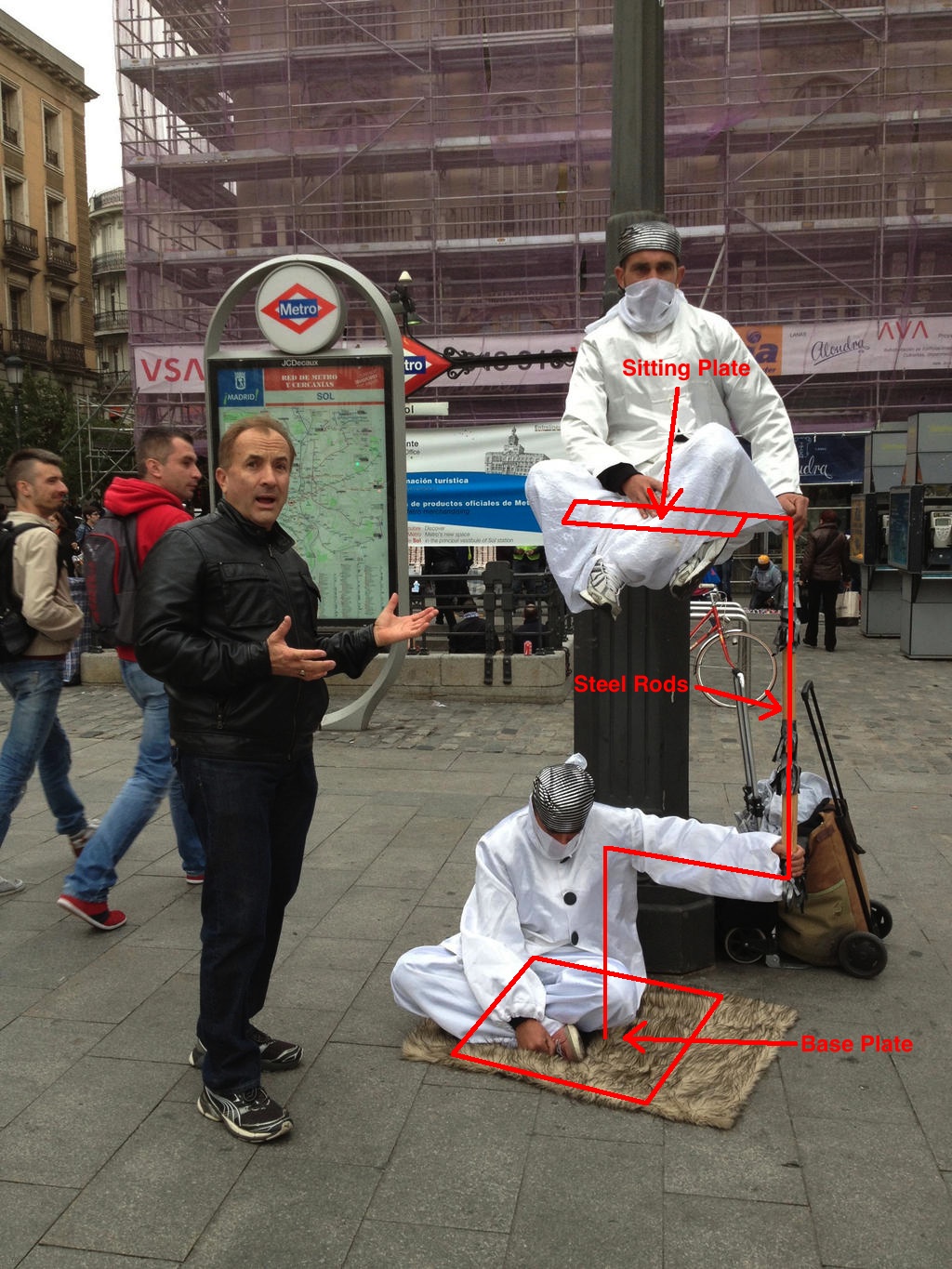A few weeks ago, Michael Shermer, founder of Skeptic Magazine and the Skeptics Society, posted this photo on his Twitter account:

It’s an amazing trick, to be sure, but how is it done? Here is another angle:

Unceremoniously cutting to the chase, we already know how the trick is done—with conveniently placed steel rods and plates—but why is it so easy to do? Why doesn’t it involve elaborate rigging or scaffolding? Prepare yourself for some physics.
Modeling Magic
Let’s go ahead and assume that the connections between the steel (or whatever material they use) can withstand the loading of the “levitating” person. Here’s what I see in the first picture:

To fit underneath the carpet, the plate must be rather small. And from the looks of the picture above, the sitting man isn’t that elevated therefore the plate is not too thick. A thin plate can be heavy, so you may be thinking that the weight alone is balancing the whole apparatus, but a ~180 pound man on a steel rod can produce quite a bit of force. There is more physics to it than this, though the additional weight certainly helps. It could also be the case that the sitting man is helping to balance the levitating one, but considering that this trick can also be done with one person, we’ll assume that the sitter isn’t contributing to the stabilization.
I’ll do some engineering calculations in a process called statics to sort this out. I’ll assume a 180 lb man whose center of gravity is directly above the bar connecting to the plate:

Now, the most efficient way to do this trick would be to sit directly above where the steel rod connects to the plate. This way, there is no torque in the plate-rod connection created by the levitator. This looks to be how the two-person levitation trick is set up.
The calculations are easy. To be in equilibrium, all the forces and moments (rotational forces) must cancel out. And what we are really concerned about, if we were the tricksters, is whether or not the apparatus will tip over. We can find this out by calculating how much rotational force is acting at the edge of the plate assuming nothing is moving. In the set-up above, the moment at point A is calculated by multiplying the downward force by the perpendicular distance (I guessed again here) to the point. This results in 180 ft-lbs that push the plate edge down into the ground (a clockwise force).
Here is where the trick comes in. The further the edge of the plate is away from the center of gravity of the levitator, the more stable the whole apparatus becomes. But a plate with long edges isn’t very subtle (and rugs only get so big). Therefore there must be a clever balance between rotational forces and deception. The closer the weight of the levitator comes to any edge of the plate, the smaller the moment becomes, until it becomes zero when the levitator is directly over an edge. This is the near-tipping condition.
If the weight of the man moves over any plate edge, the moment reverses, now acting to overturn rather than stabilize the pair.
In the trick involving just one person (photo below) the man cannot sit directly above the joint, and you can see the lean creating the downward rotational force:

Image Credit: TwentyTwoWords
But even here you see that the center of gravity of the man appears to be still inside the plate area.
The best of these tricksters will use a step-up with the closest balance between stability and tipping. Theoretically, the best trick would have the center of gravity of the levitator balanced directly above the center of a small, square plate. But the world is a messy place. I’m sure set-ups differ to account for wind, wriggling, and instability, making plates larger than they need to be.
Far from “unweaving the rainbow,” I think that using science to discover a clever bit of engineering is far more interesting than walking past this demonstration on the street, only casually attracted to the cloaked men.
Kyle Hill is the JREF research fellow specializing in communication research and human information processing. He writes daily at the Science-Based Life blog and you can follow him on Twitter here.